"The ruins were just a reminder that what had been was no longer. That everything we are will be gone someday. That I will be forgotten." -Megan Miranda
Some four-and-a-half billion years ago, a ultra-massive cloud of cold gas and dust collapsed, giving rise to thousands of stars of all different types, from hot, massive, quick-burning blue stars down to low-mass, cool red dwarfs. And within a few hundred million years, that open star cluster dissociated, flinging the individual stars that once made it up throughout the galaxy. The lone remnant of that cluster known to us lights up our daytime sky: our Sun.
There are over a thousand known open star clusters in the Milky Way, with 33 of the brightest and closest making their way into the Messier catalogue. But while the vast majority of open star clusters don't even make it to an age of even one billion years before gravity takes its ultimate toll and flings the stars off into interstellar space, there's one star cluster in the Messier Catalogue that's old enough that the Sun would be right at home.
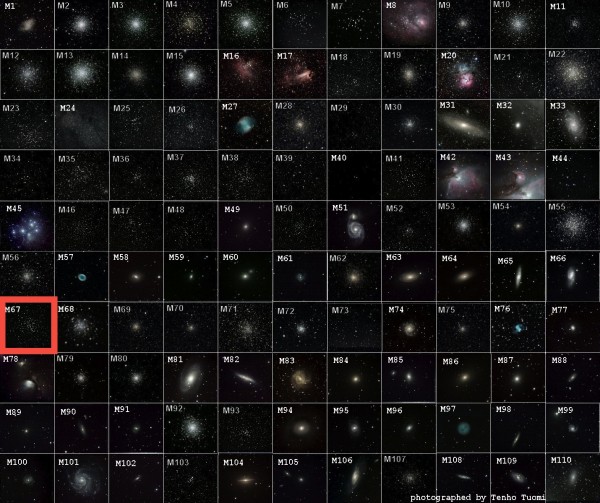
Image credit: Tenho Tuomi of http://www.lex.sk.ca/astro/.
Visible all night long during the winter, the open cluster Messier 67 is the oldest open star cluster in the Messier Catalogue, and here's how you can find it tonight.

Image credit: Me, using the free software Stellarium, http://stellarium.org/.
As you move to the east of Orion and Sirius, you can find the two very bright stars Procyon and, a little farther, Regulus, the 7th and 20th brightest star systems in the entire night sky. About midway between the two, just a tiny bit north of the imaginary line connecting them (and just a little south of Praesepe, M44, our Messier Monday from just a few weeks ago) is the faint open cluster M67, which you can find in a pair of binoculars by finding Acubens, the brightest star in the constellation of Cancer.

Image credit: Me, using the free software Stellarium, http://stellarium.org/.
Messier 67 appears faint and nondescript, and there are no bright, blue stars in it, which is your first clue that it's very old! Remember, when star clusters are first born, they form the following seven different classes of stars, in roughly equal mass-fractions.
However, the biggest, bluest, brightest stars burn up their fuel the fastest, and so have the shortest lifetime. The Pleiades, for example, at about 80 million years old, has no more O-stars, but plenty of B-stars. Praesepe, mentioned earlier, at about 600 million years of age, has no O-or-B-stars, but plenty of A-stars.
But Messier 67 is so old that it doesn't even have any A-stars left, and the "bluest" star type present is of class F!
At only 2,600 light-years distant, it's a relatively close open cluster, and there are over 500 stars in it, with more than 100 of those being Sun-like (or G-type) stars. There are also -- as you can better tell in the image below -- quite a few blue stars in this cluster, mostly concentrated at its core.
But these are not original, main-sequence stars; these are blue stragglers, or stars that have formed from the merger of lower-mass stars at the core of this cluster.
You see, this cluster wasn't always so "light," with a total mass of around 1,000-to-1,400 solar masses, depending on whom you ask. But as clusters age, the heavier mass stars move towards the center and the lighter-mass stars either migrate towards the outskirts or get kicked out, in a process known as mass segregation, which M67 has clearly undergone.
As a result, the stars that remain after some 4-billion-years (the latest estimate of the age of M67, although modern estimates range from 3.2-to-5 billion years) are much more tightly bound, gravitationally speaking, than younger star clusters are.
But the simple way to "date" the age of a cluster is to plot its stars on a color-vs.-magnitude diagram, and the curve that results allows you to figure out the age of the cluster from the stars that make it up!
Messier 67, because it "turned off" of the main sequence at the point illustrated above, can be reliably dated to be "around" 4 billion years old, making it the oldest open cluster in the Messier catalogue. (The oldest open cluster thus far discovered is Berkeley 17, at a whopping 10-to-13 billion years old!)
Because of the way its stars are now concentrated together, Messier 67 is expected to remain together for perhaps another 5 billion years before dissociating, provided it doesn't experience a catastrophic gravitational interaction with an object capable of tearing it apart!
At only 12 light-years across, M67 is one of the more compact open clusters known, and the stars in it are not only the same rough age as our Sun, they also have a nearly identical elemental composition to our Sun, which means that these 500 known stars may have worlds and planetary systems very much like our own!
The best-resolution image we have of the core of this cluster comes from the Sloan Digital Sky Survey, which really shows off not only the colors of the stars inside, but also the very dim red M-dwarfs beyond the reach of other telescopes!
As always, you can click to enlarge the above image, but to best show-off the resolution, I've taken just a narrow strip from the middle of it, to showcase exactly what we can see inside.
And finally -- I'm not entirely sure -- but either there's a funny, ring-shaped artifact around one of the bright, red-giant stars at the lower-right of the SDSS image, or we're seeing the early stages of gas being blown off into a planetary nebula!
After all, the cluster is the right age for this to be happening, and is that what we're seeing here? Or is it a problem of overexposing a relatively bright, red giant star with the camera/CCD in the telescope itself? I'm not sure: you be the judge!
Regardless, I hope you enjoyed a look inside one of the most unremarkable-looking objects in the Messier Catalogue, that just happens to have one of the most remarkable stories behind it!
So far, including today's entry, we've taken a look at the following Messier objects:
- M1, The Crab Nebula: October 22, 2012
- M8, The Lagoon Nebula: November 5, 2012
- M13, The Great Globular Cluster in Hercules: December 31, 2012
- M15, An Ancient Globular Cluster: November 12, 2012
- M30, A Straggling Globular Cluster: November 26, 2012
- M37, A Rich Open Star Cluster: December 3, 2012
- M41, The Dog Star’s Secret Neighbor: January 7, 2013
- M44, The Beehive Cluster / Praesepe: December 24, 2012
- M45, The Pleiades: October 29, 2012
- M67, Messier's Oldest Open Cluster: January 14, 2013
- M78, A Reflection Nebula: December 10, 2012
- M81, Bode’s Galaxy: November 19, 2012
- M102, A Great Galactic Controversy: December 17, 2012
Come back next Monday (and every Monday) for another Messier Monday, where we'll take another look into the brightest, closest deep-sky objects visible from right here in our own backyards!


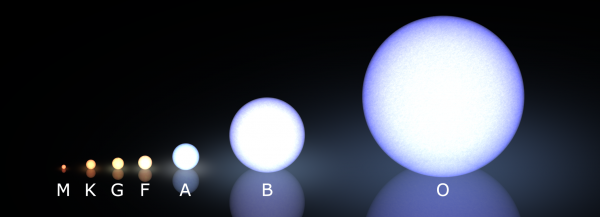


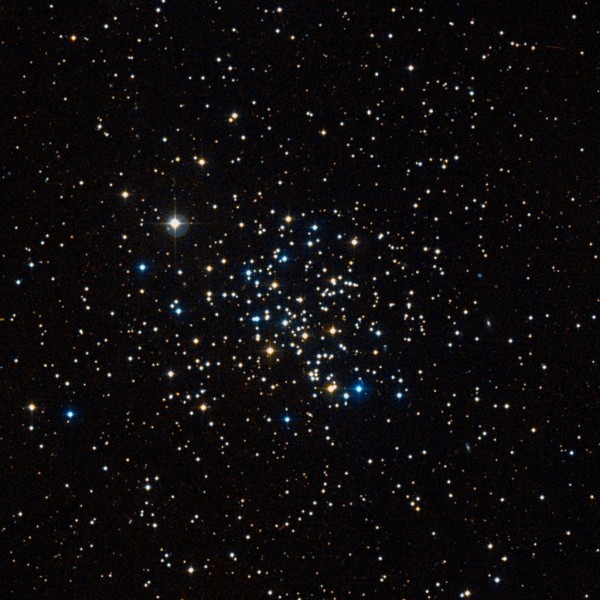
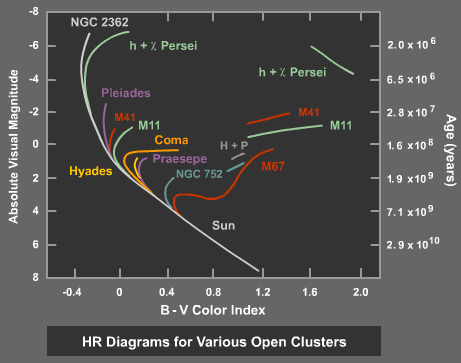

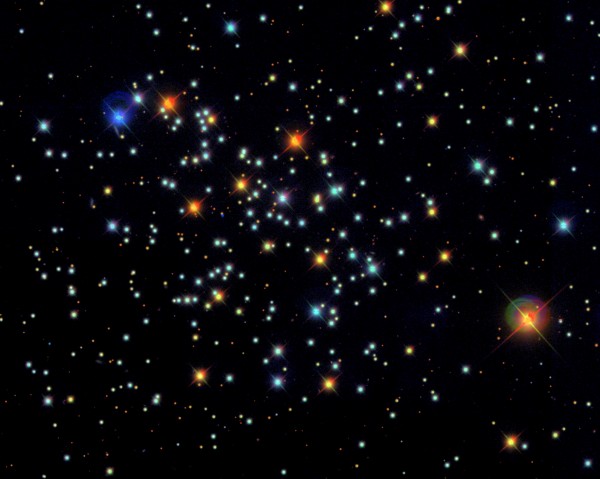


Age about right; elemental contents almost identical...Might we be looking at the nursery that birthed Sol?
Ethan, could you someday post an explanation of how stars move off the mainline of the HR diagram, and why different stars seem to do so at different colors? Thanks, as always!
Ethan,
That funny-looking star in the final picture is the result of ghosts in the red and green filters appearing at slightly different angles, due to small differences in the optical paths. In other words, it's an image artifact, not a young planetary nebula.
Another great post. Good opening quote too!
Ethan,
The two spike artefacts are exactly along the major axes of the ghost images (Michael Richmond) which is very suggestive that the images are ghosts
If you'd said that about the SECOND to last picture, I'd agree.
However, the optical path differences aren't that big to produce such a large achromatic aberration around a star like that. Look at the other stars, they would be affected by the problem just as much.
Dear Mr. Wow,
Do you know what a ghost image is? Are you aware of the layout of the chips in the focal plane of the SDSS mosaic camera?
I'm thinking that it must be an image artifact from SDSS, because if it were actually a planetary nebula, it ought to have shown up on this 2MASS image of the cluster, where that same star is in the upper-left of this image.
But there is no indication of anything other than a star there, and so I'm thinking ghost image is exactly right.
Ethan
You really give a very nice education. Not that I catch it all; but I do appreciate the education.
And it's not a passive education; you force me to look up open cluster again, think about the evolution of our sun, put in context the idea of the classes of stars, and show a use of the HR diagram. You bring all these little ideas together not as just abstract ideas; you weave an excellent story. Thanks.
And you put in context just how vast a knowledge, modern astronomy has gathered about even such a little corner of the universe.
Not that there isn't a lot more to know. And not that sometimes astronomers don't wax too poetic about the big picture of the universe. But for me anyway, when I understand a little bit more just how rich and deep our astronomy knowledge is even about some speck of the night sky called M67; well then I've got to give a little bit more respect (yes that is the correct word) when astronomers talk about more difficult to understand ideas (e.g. dark matter).
I mean the work of modern astronomy is like Copernicus, Brahe, Kepler and Galileo on supersteriods. What an achievement. We (I any way) need to be specifically and continuously reminded of the achievement of modern astronomy!
"Do you know what a ghost image is?"
Yes.
I even know what achromatic means.
Do you?
"The two spike artefacts are exactly along the major axes of the ghost images"
The vanes holding the secondary will produce spokes. Diffraction around the spoke causes a long thin line perpendicular to the vane.
It's one reason why this telescope has curved vanes:
http://www.firstlightoptics.com/vixen/vixen-vmc110l.html
I apologize for being so curt in my response earlier. Let me try again.
A ghost is an optical defect caused when light travels down through the optics of a telescope (as it should), but, before it reaches the detector, it bounces off one of the surfaces instead of going through it. For example, if light bounces off the back end of a filter (the end close to the CCD) back up toward the sky, but then bounces back down off the front end of the filter, it may eventually reach the CCD again after taking a slightly longer path. That longer path causes the light ray to strike the detector at a place slightly offset from its original destination. In many cases, the dominant type of internal reflection creates a big, out-of-focus image of the star, offset to one side from the star itself. You can see an example at
http://www.andromedaproject.org/#!/guide/type/artifacts
Now, the SDSS camera has six rows of CCD chips with 5 chips in each row. See the pictures inhttp://www.astro.princeton.edu/PBOOK/camera/camera.htm. Stars drift along each row over the course of about 7 minutes, spending about 55 seconds drifting across each of the chips. If you look at the picture, you'll see that the chips with green filters are located at different spot in the focal plane than those with red filters, or blue filters. That means that light entering each chip is coming into the chip a slightly different angle. That, in turn, means that the light rays bouncing internally off the surface of each filter will create ghost images which are oriented at a slightly different angle with respect to the main stellar image.
It is an image artifact.
If you look at the m67_ssds-600x479.jpg you posted, the blue star in top left part has the same halo but in blue channel.
Thank you. I love Mondays.
There ARE artifacts. But the old stars have those sharper red spikes which are probably artifacts, the bluewhite stars have blue spikes which are probably the SAME artifacts, but more blue.
And then one star all on its own has a great big rosette AND those red spikes, just like the other stars.
That's because the one star is many times brighter than all the others, which means that its ghosts -- which are a fixed fraction of the brightness of the star itself -- are bright enough to appear above the background.
Look, Mr. Wow, I was part of the team which built the software to reduce the SDSS images. You can look it up if you like. On this particular issue, I know whereof I speak.
Michael, the quality of the "ghost" as you put it is very much different from the other stars, and the brightness of them are not much lower as can be told from the length of the diffraction spikes off them.
The deeper red spikes? Happy with them being ghosts.
The petal structure?
No.
Look at them all together in the last photo.
Look how the bloom on the others fades out to nothing at the edge whilst the one in the bottom right has a definite edge that is bright and coloured.
The colour may be an artifact, but the shape and quality of the bloom is very different.
Unless you're saying that this is a sensor mosaic rather than one single sensor.
Wow, there is nothing there. It's just a miss-alignment of RGB channels. If you open the image in Photoshop or similar where you view each channel separately, you can clearly see what's going on.
"Wow, there is nothing there. It’s just a miss-alignment of RGB channels. "
That's what's happening on ALL of the stars, SL.
However, one of those stars has a very different issue going on IN ADDITION to that affecting the others.
look at the second to last pic.
All the brighter stars have the diffraction spokes from the secondary support.
They also all have (no matter if blue or red) a greener spoke top-left to bottom-right and a redder spoke perpendicular.
The top right of each brighter star has several (I'd call six) much smaller spokes to the top-right side of the stars, no matter if it is red or blue, though in the case of the blue, it's a much more purple colour and less visible.
Those will be artifacts.
Look at the second to last picture and the blobbing star in the bottom right.
Spokes like the others. Colour cast on the axes like the others.
And an extra feature.
Note that if it is a mass ejection, it would be cooler and less optically thick, therefore more chromatically distinct. Looking at the R channel and the B channel separately won't help distinguish a colour aberration from a planetary nebula forming. Look at the ring nebula and separate out the channels there into R and B.
Hope this helps ;)
Did it in a rush, but picture speaks a thousand words :)
http://img11.imageshack.us/img11/5111/imageanalisys.jpg
Aye, this is very much a visual explanation.
If I'm not mistaken, however, your image are separating out the beyerised RGB map and not actually reading the R, G and B channels.
Since the beyer mask puts some of the R and G pixel into the B, some of the B and R pixel into the G and some of the B and G pixel into the R, you're not getting the R, G and B pattern.
So that aside, I can see what you're talking about now. Rubbish about the differing paths of the RG and B channels was completely a red herring (no pun intended).
The assertion is that the shape is the reflection of the BLUE star top left on top of an inconveniently placed red star?
Or that the ring is an artifact of something not on-chip but exacerbated by appearing very close to two bright stars?
NOTE: off-centre planetary rings aren't unusual. Fairly common in fact, though that would be easily debatable since planetary nebulae are pretty rare to spot, being temporary objects in a stellar lifecycle.
I'm not saying it's the reflection of the blue star. I don't know enough to state that. What I am saying is that both blue and red star have THE SAME artifact. Only in the blue star it's mostly visible in blue channel.
The rings are definately artifacts, but weather of optics or chip, I don't know. Altough mr Richmond gave a pretty clear explanation of that part. And if he indeed worked on the project, what more is there to say.
I, for one, am convinced it's just a regular star and what we see is ghost/artifact.
Note: not using the B channel on a colour CCD is one method I use with my dad's F5 Achromat to remove the blue fringe. It works much less well on the RGB image from a webcam where you can't get RAW data access.
"The rings are definately artifacts, but weather of optics or chip, I don’t know."
If they are all artifacts, they'll need to be off-chip.
The analysis you did isn't careful enough to know this, but it appears that the rings are out-of-focus images from the objective and would HAVE to be reflected at least once to the blue star and back for a second go back at the red star.
It can only be proven by using another imager in the region operating at similar exposure/gain.
But at least I can now see what people are talking about.
By the way, professor Richmond, thank you very much for the link to SDSS camera technical page. It was very informative read. Must be great to be part of a team that builds and uses such instruments! :) My respects.
Mr. Richmond's explanation of internal reflections in the filters seems perfectly adequate to me. Different paths makes perfect sense, as it's not a Bayer filter, it's rows of chips with each row having a separate filter covering the chip. The (non-htmlified) link he posted shows it clearly.
However the Winipedia article on M67 you link to in turn links to a paper that concludes the sun could not have come from M67. http://arxiv.org/pdf/1201.0987v1.pdf
There are several problems with that, CB. They may be explicable, but they haven't been. Under the explanation given:
The blue star would have triple ghosting for each colour as the red star did.
The offset would be very much more similar for the blue star as the red star.
The other stars would be showing at least some similar ghosting, according to the length of the diffraction spikes on those stars. Their length gives you a good idea of how bright the star is.